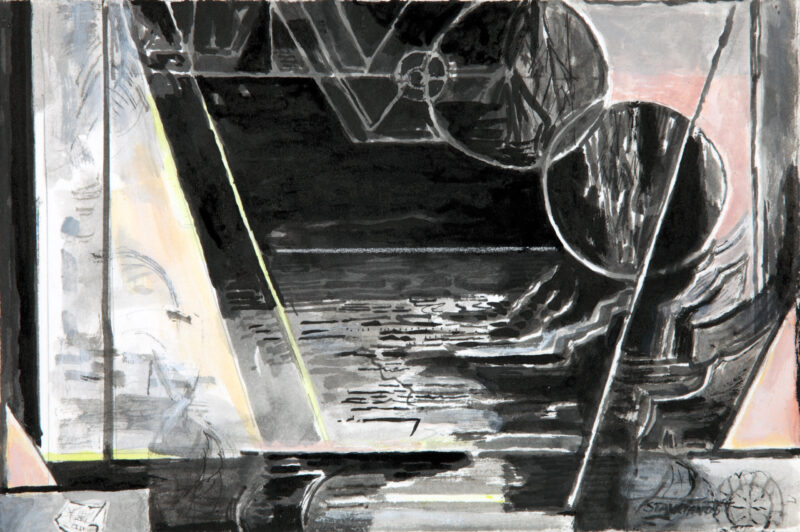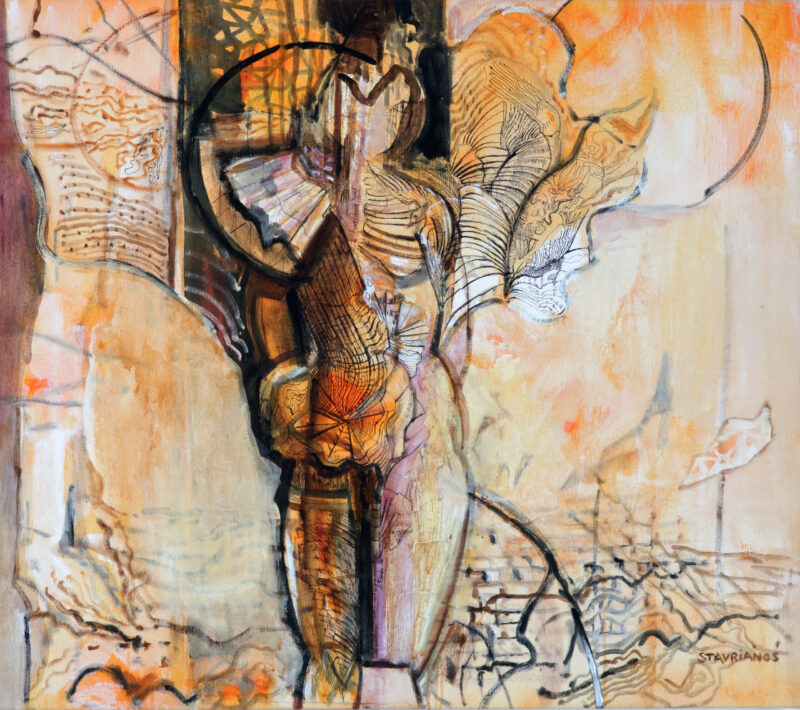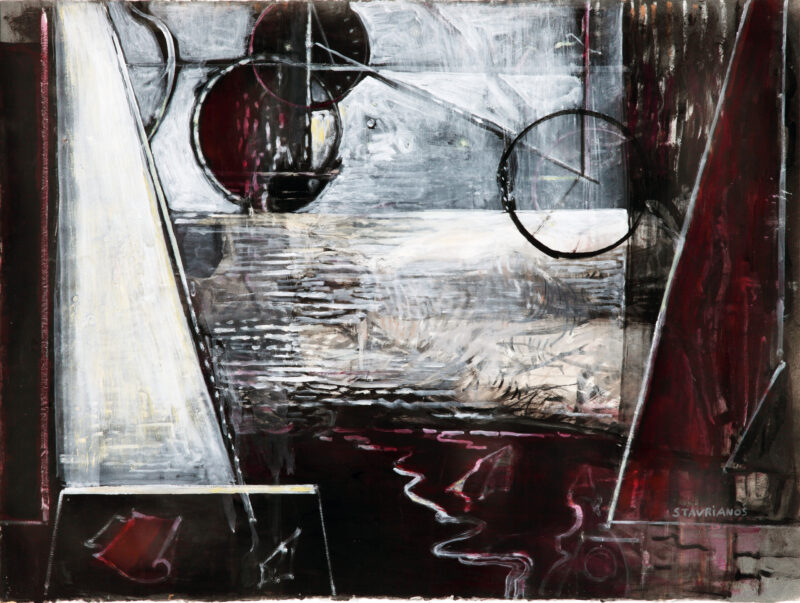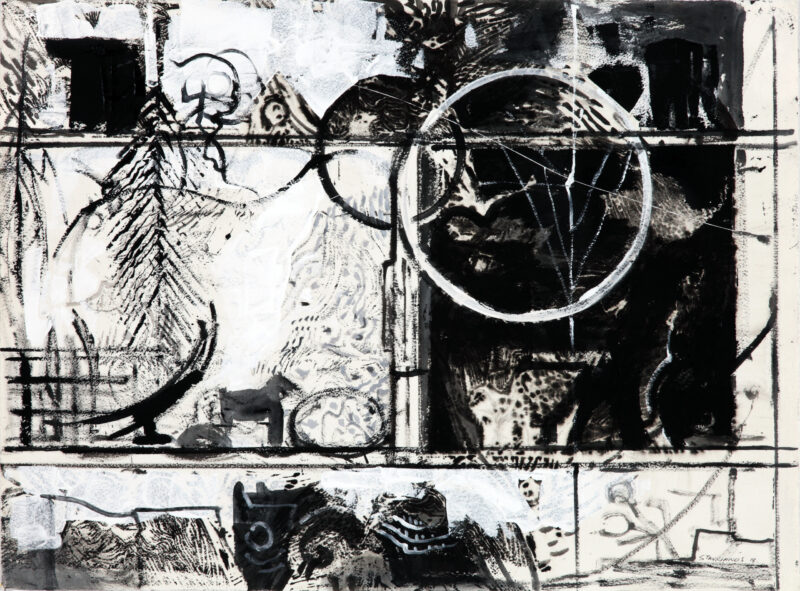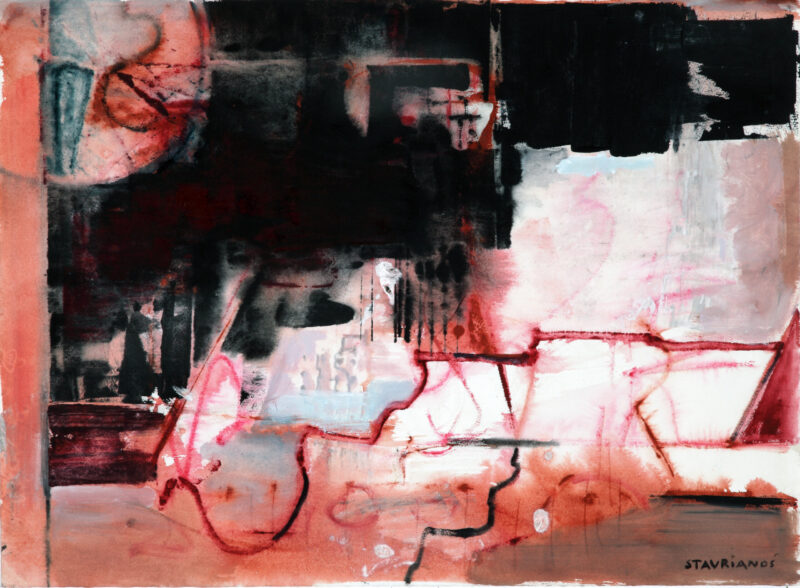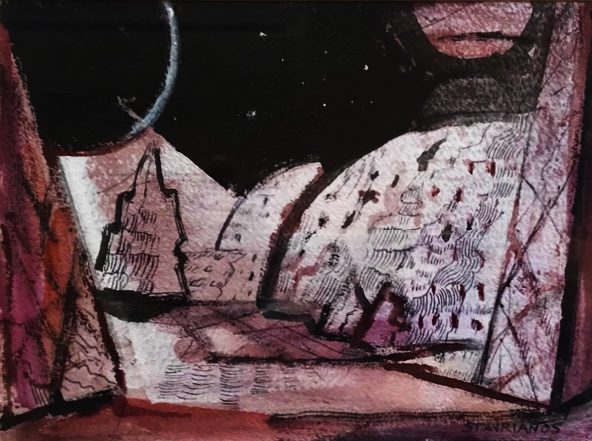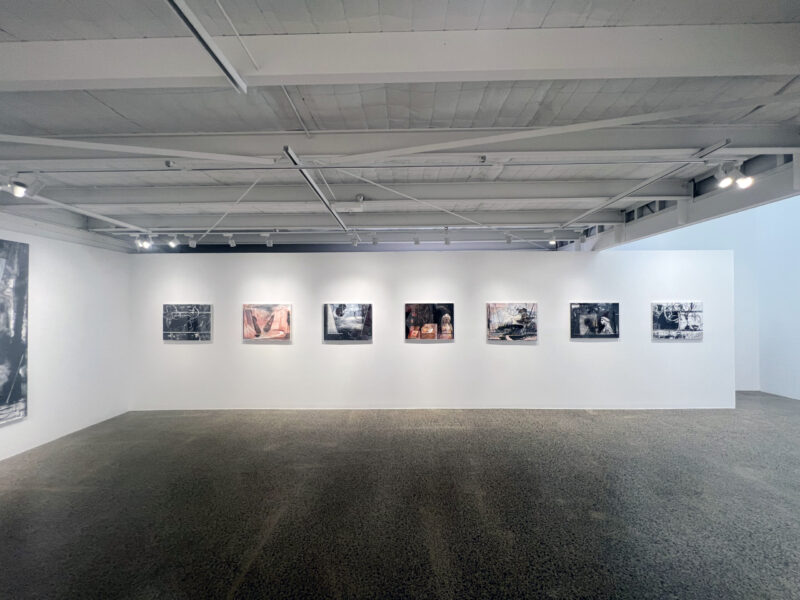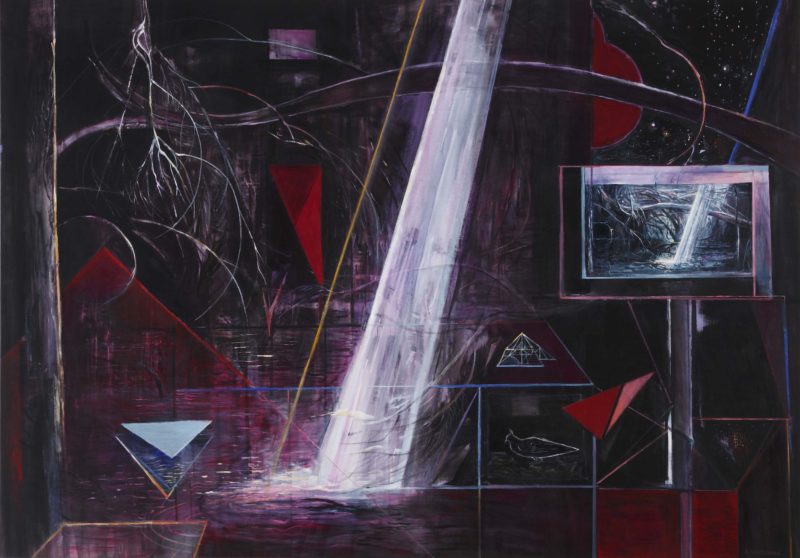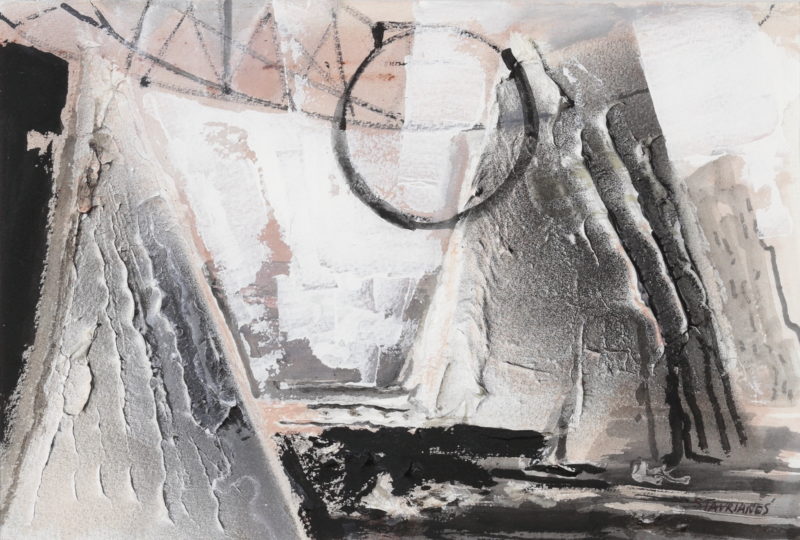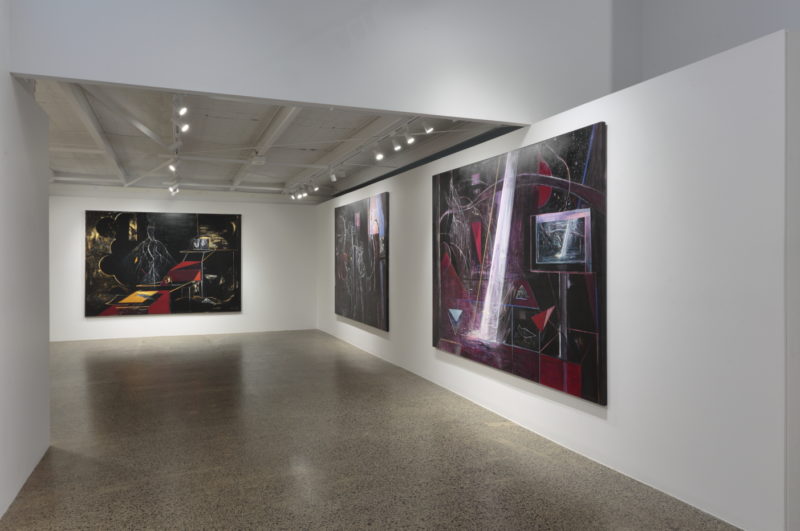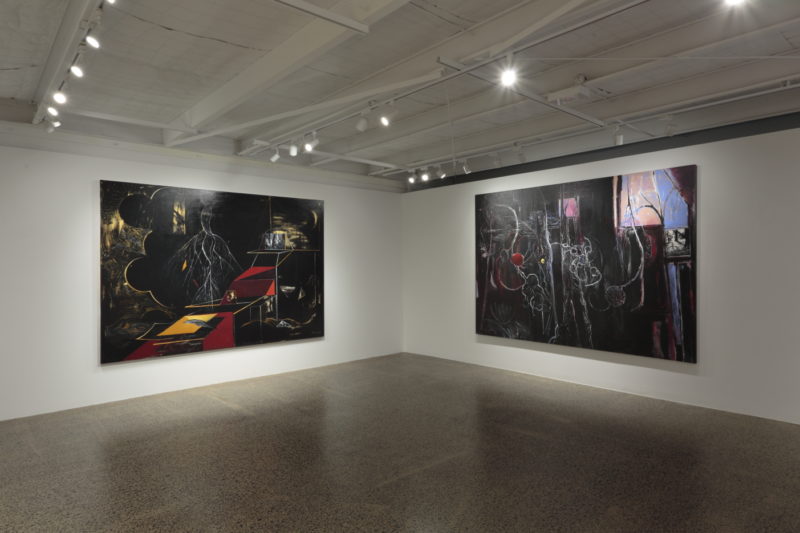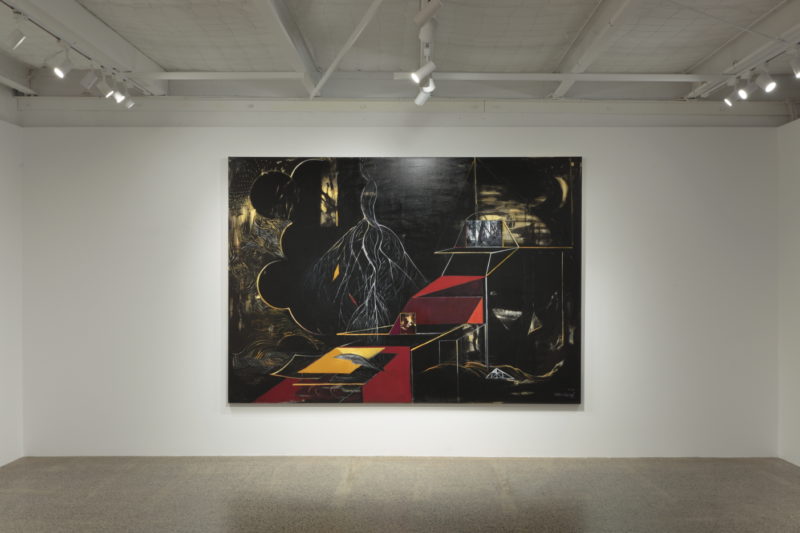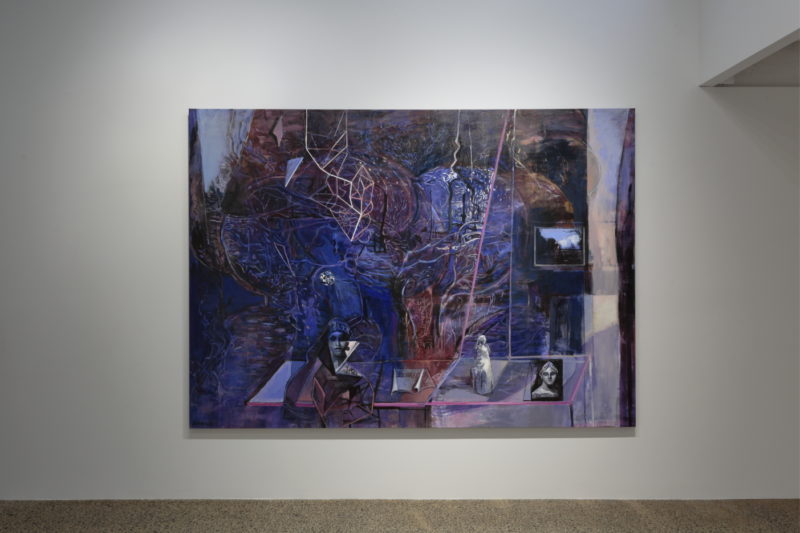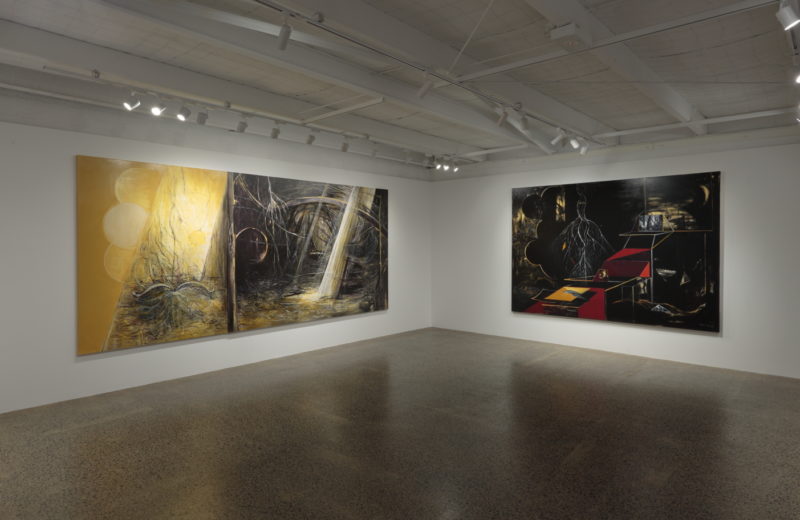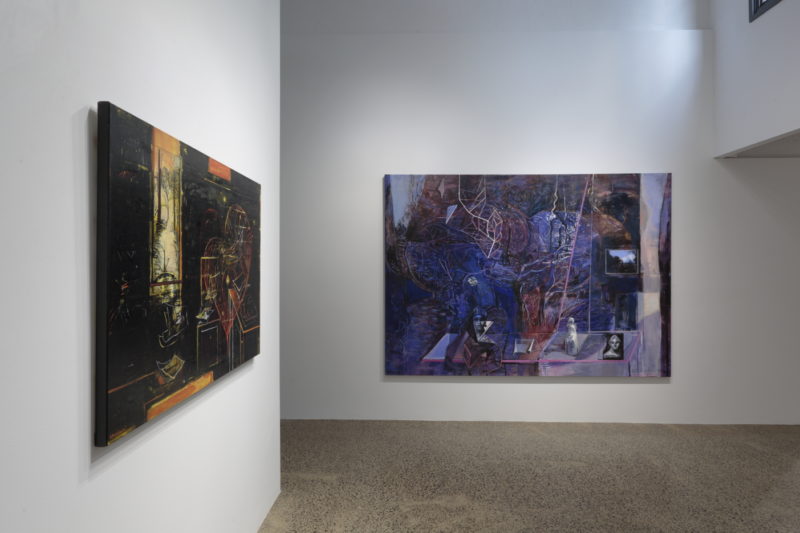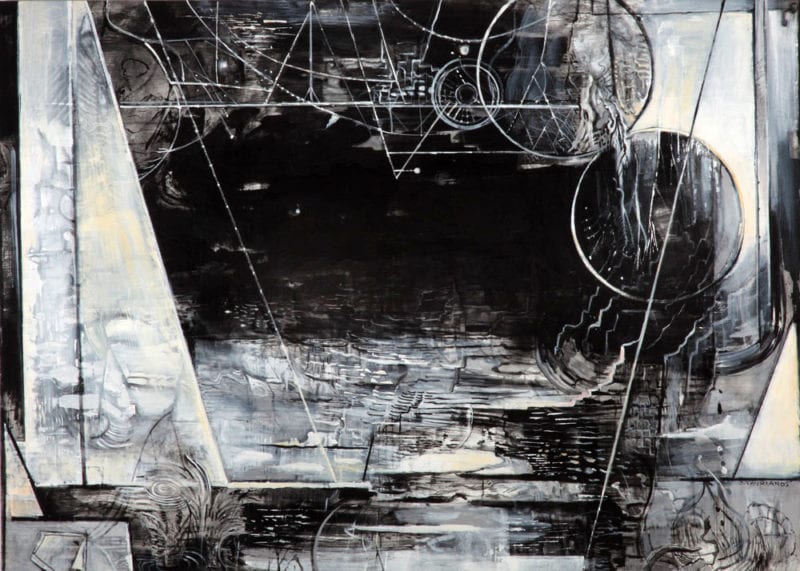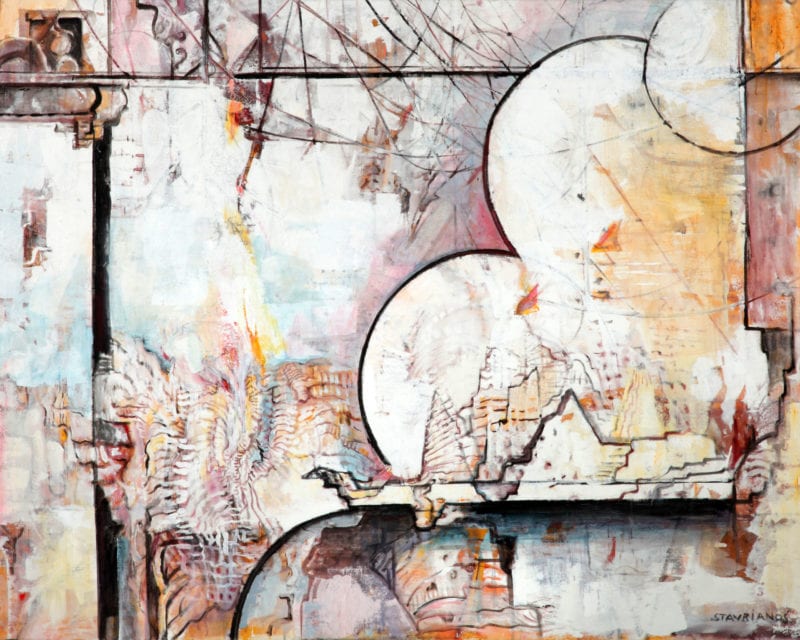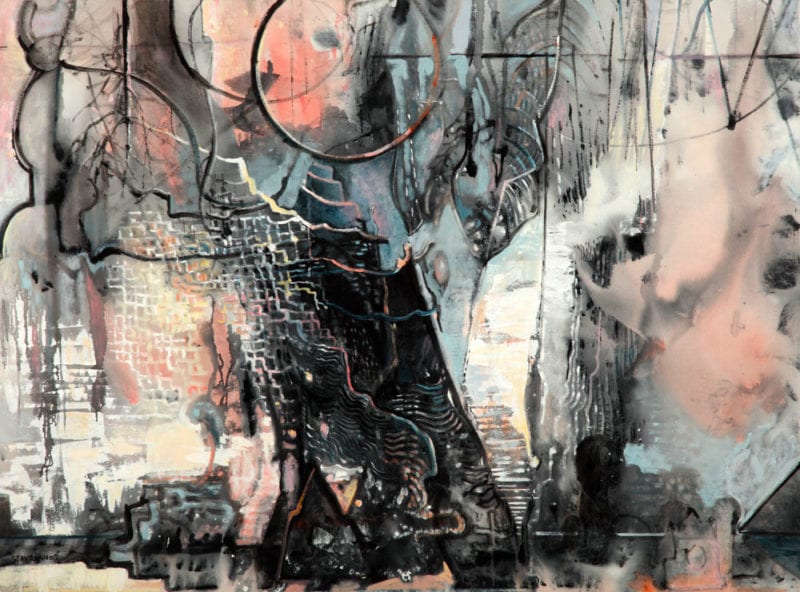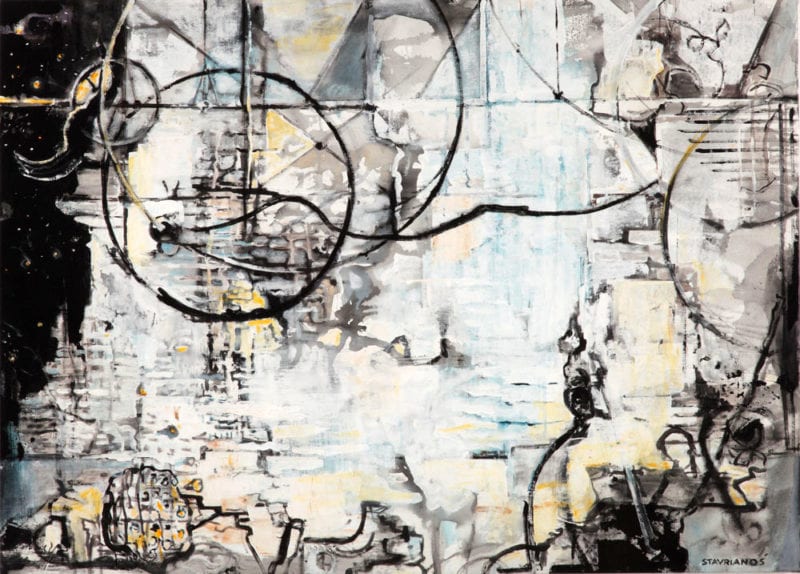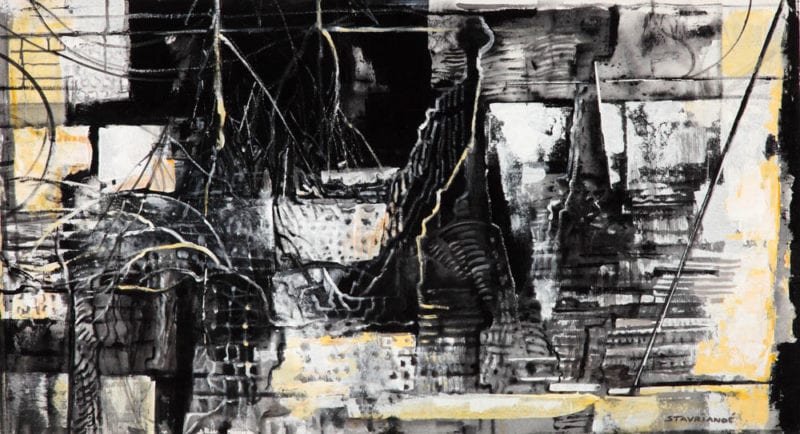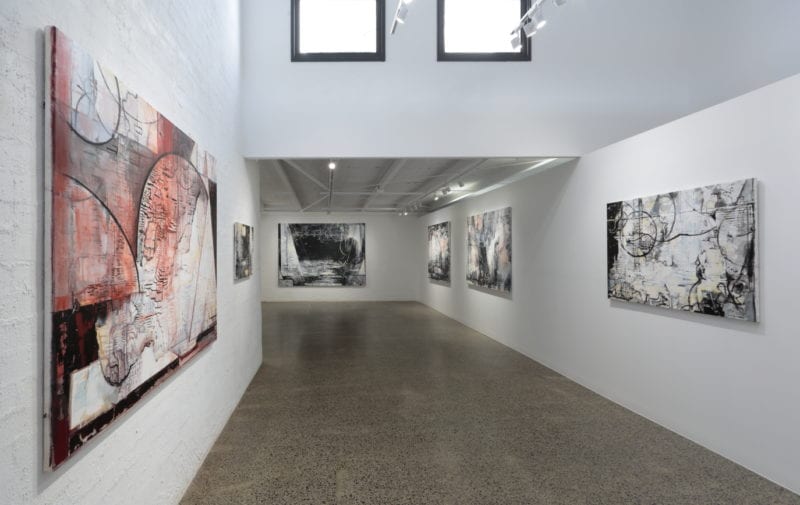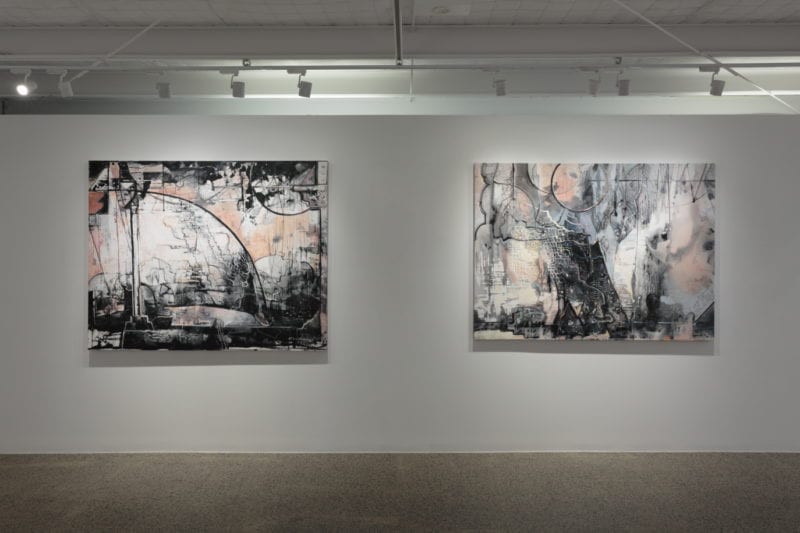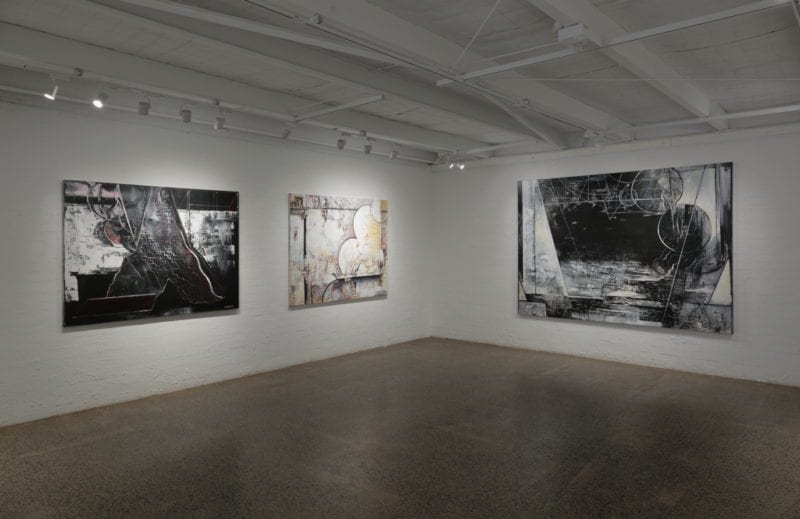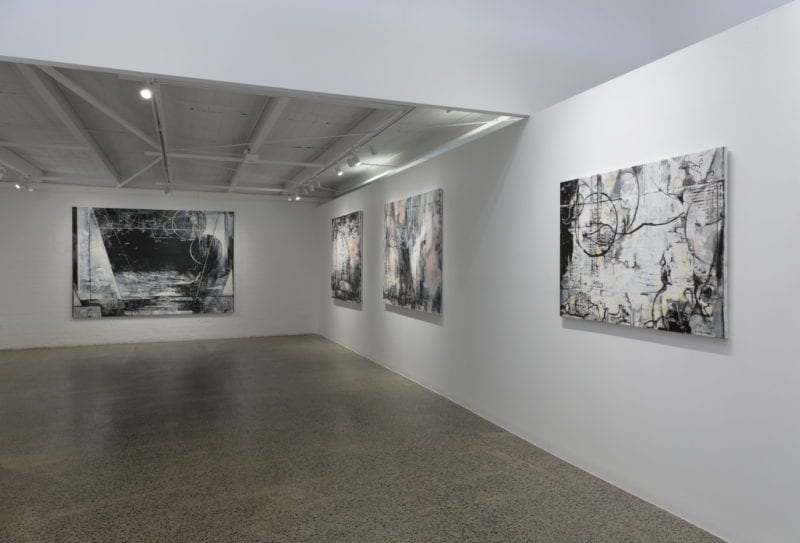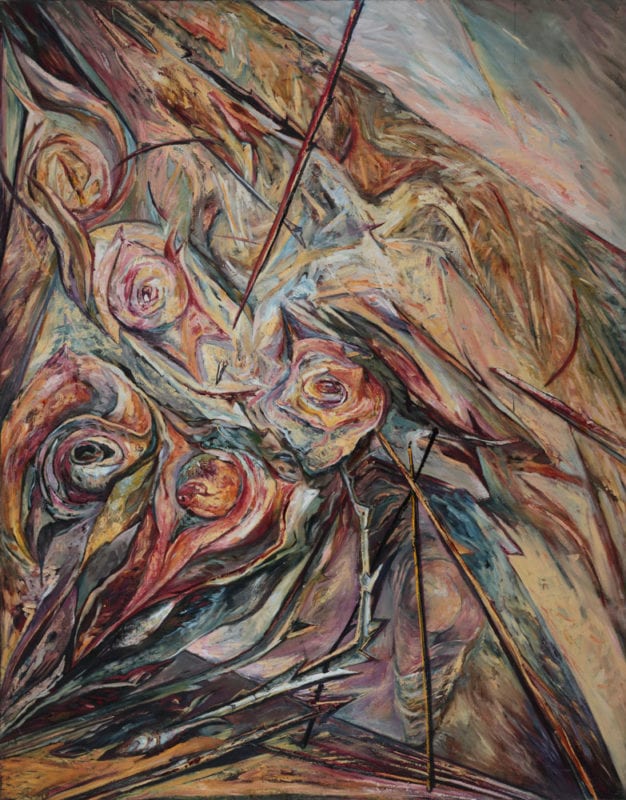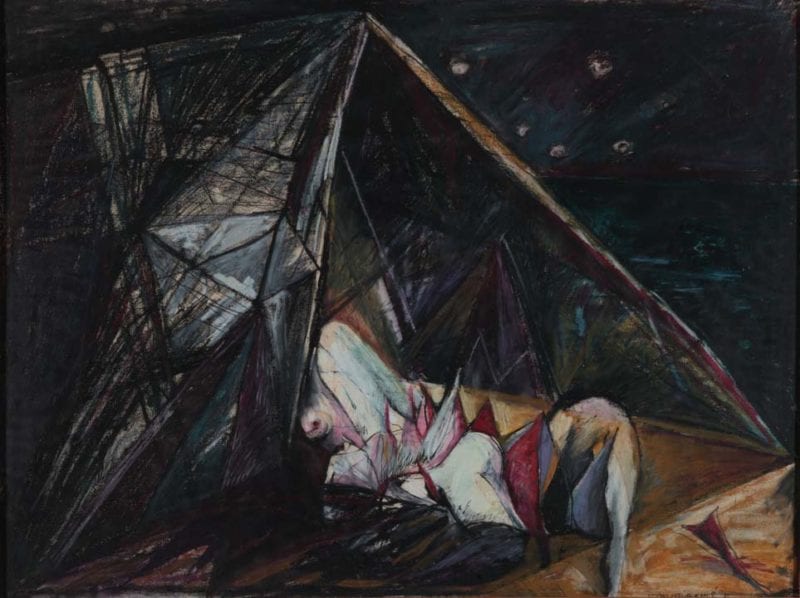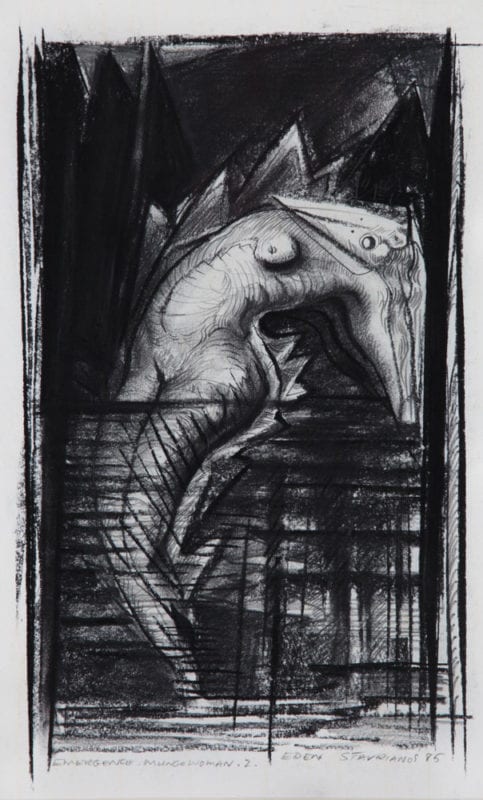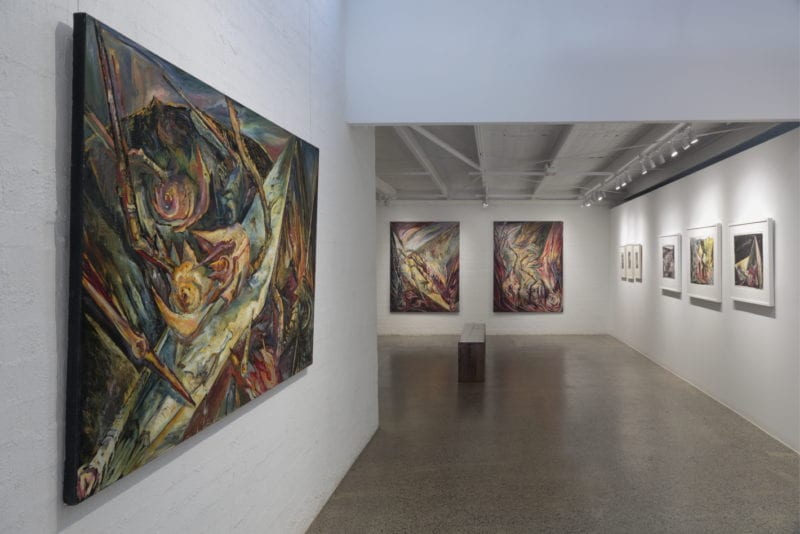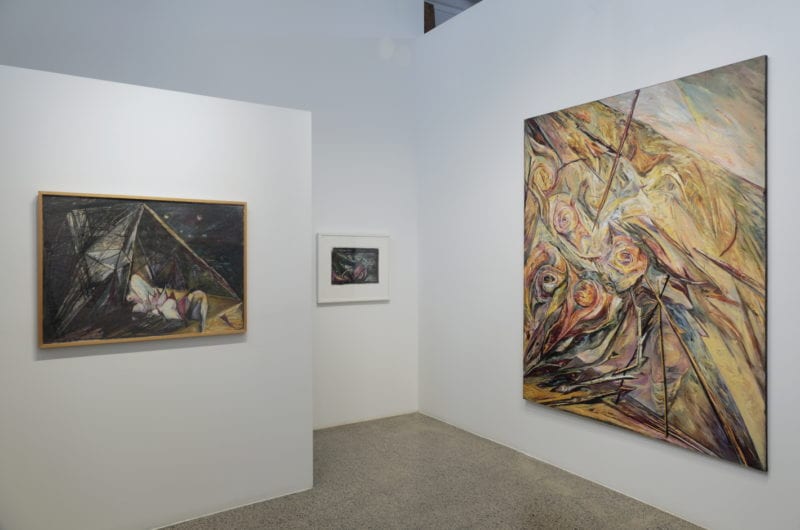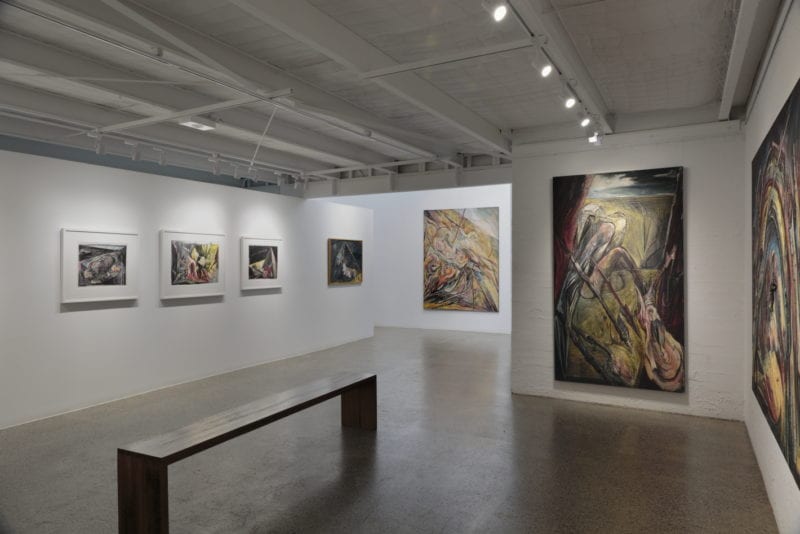WENDY STAVRIANOS

BIOGRAPHY
Wendy Stavrianos has held regular solo exhibitions since 1967 in Melbourne, Sydney, Brisbane and Perth. She was awarded a Diploma of Fine Art, Royal Melbourne Institute of Technology (1961) and an M.A. Fine Art, Monash University (1997).
Institutional exhibitions of Stavrianos' work include 'Mantles of Darkness' (1994, touring regional galleries including Ararat, Castlemaine, Geelong, McClelland and the Nolan Gallery ACT), 'A metaphysical edge' at Bendigo Art Gallery (2005), 'Night's Edge' at the Art Gallery of Ballarat (2008) and ‘Fragments of Memories’ at LaTrobe University Museum of Art (2011). Touring retrospectives to regional galleries in Victoria, Queensland and New South Wales have been staged by the Sydney University of Technology (1999) and The Drill Hall Gallery, Australian National University (1997).
A monograph of Stavrianos' work was published in 1996. She has been a finalist in the Art Gallery of New South Wales' Sulman Prize (2001, 2002, 2007, 2009) and is a recipient of the Swan Hill Drawing Prize (2000), the Dominique Segan Drawing Prize, Castlemaine, Victoria (1992) and the MPAC Drawing Acquisitions Award (1977).
Stavrianos' work is held in the collections of the National Gallery of Australia; the National Gallery of Victoria; the Art Gallery of New South Wales; the Queensland Art Gallery | Gallery of Modern Art; the Art Gallery of Western Australia; the Museum and Art Gallery of the Northern Territory; Artbank; Parliament House, Australia; Heide Museum of Modern Art; the Australian Catholic University, regional galleries, tertiary collections, and corporate and private collections in Australia and internationally.
ARTIST CV
DOWNLOAD PDF
WORKS
CONTACT GALLERY FOR PRICE INFORMATION
PAST EXHIBITIONS
CONNECTING THREADS
15 NOVEMBER TO 2 DECEMBER 2023


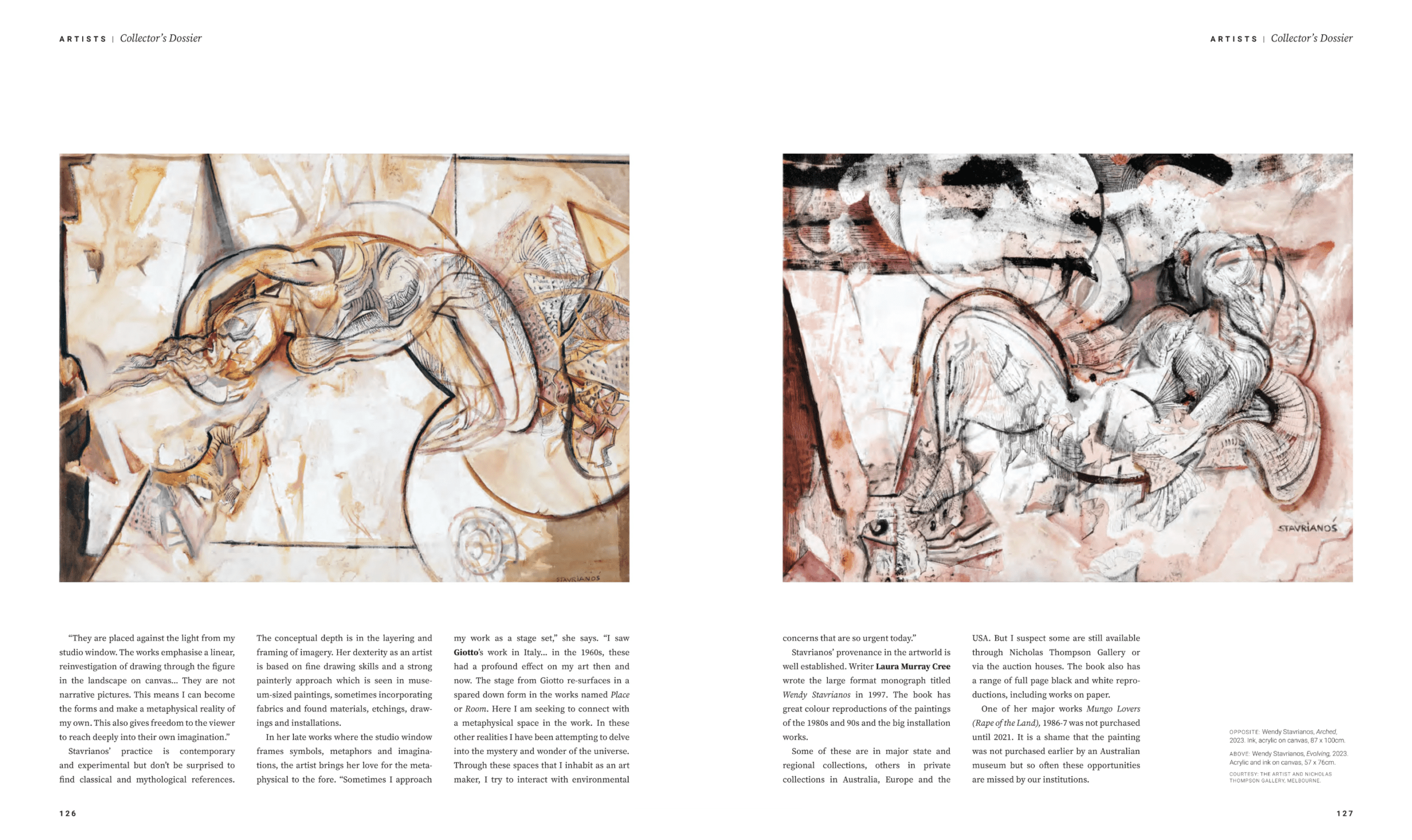

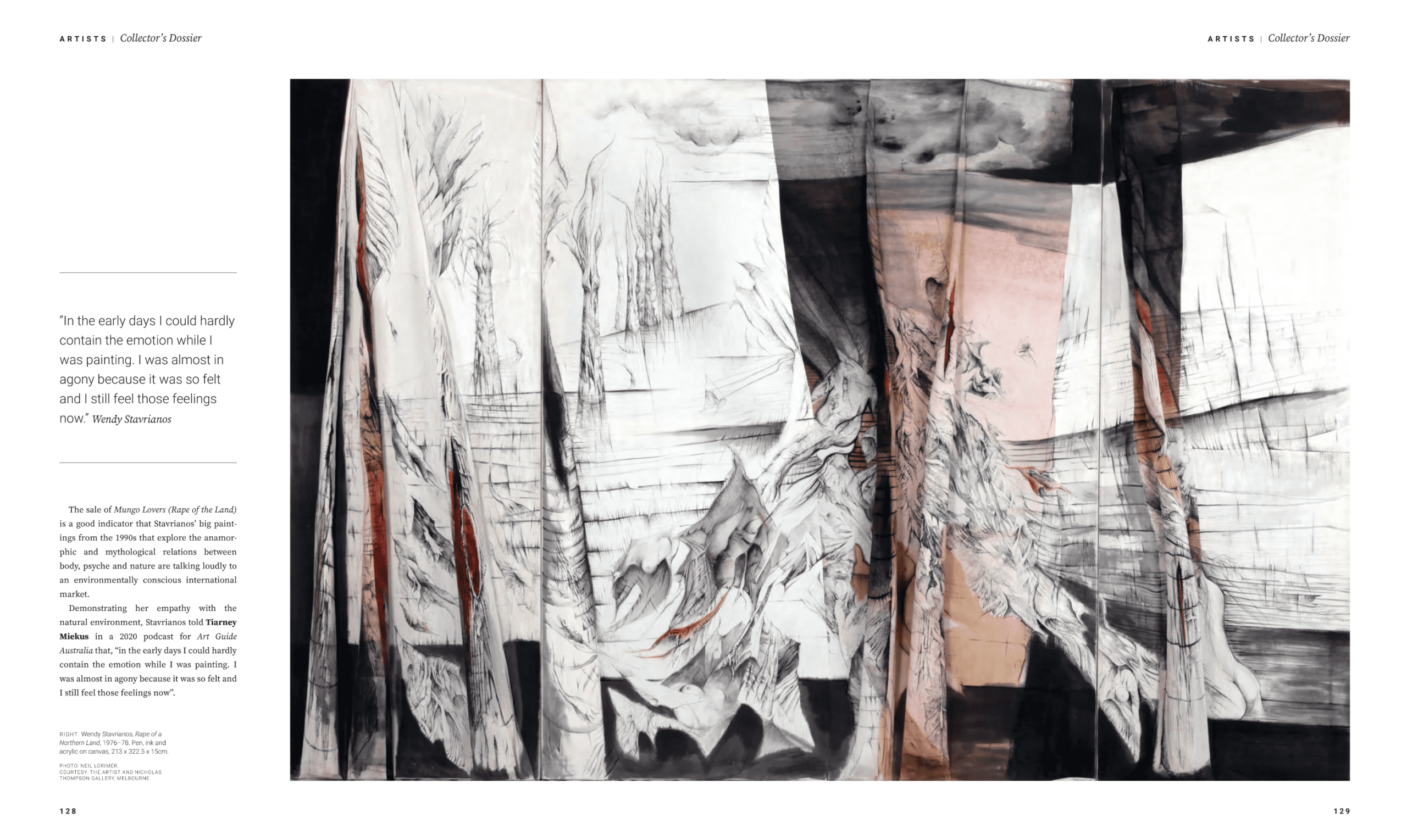



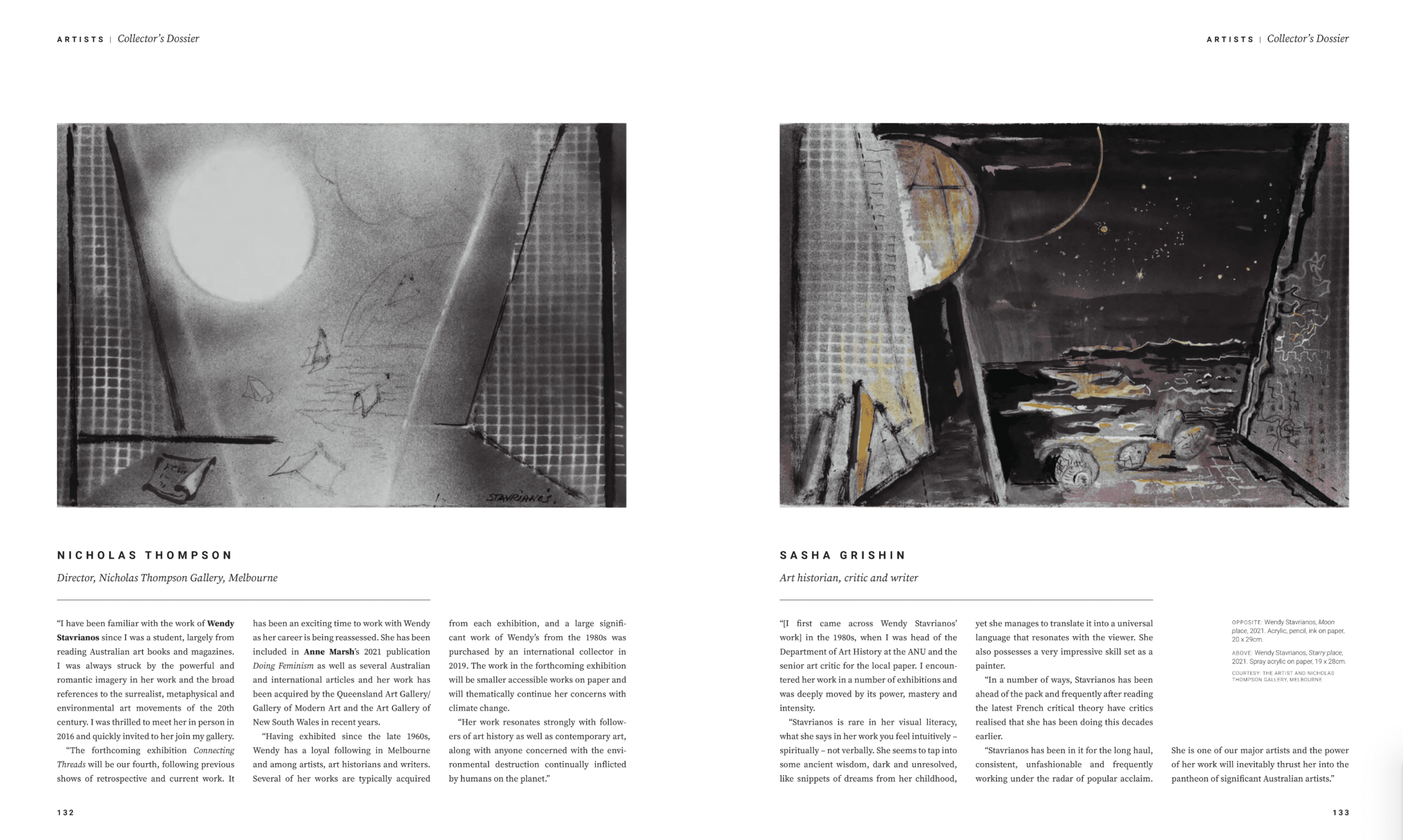

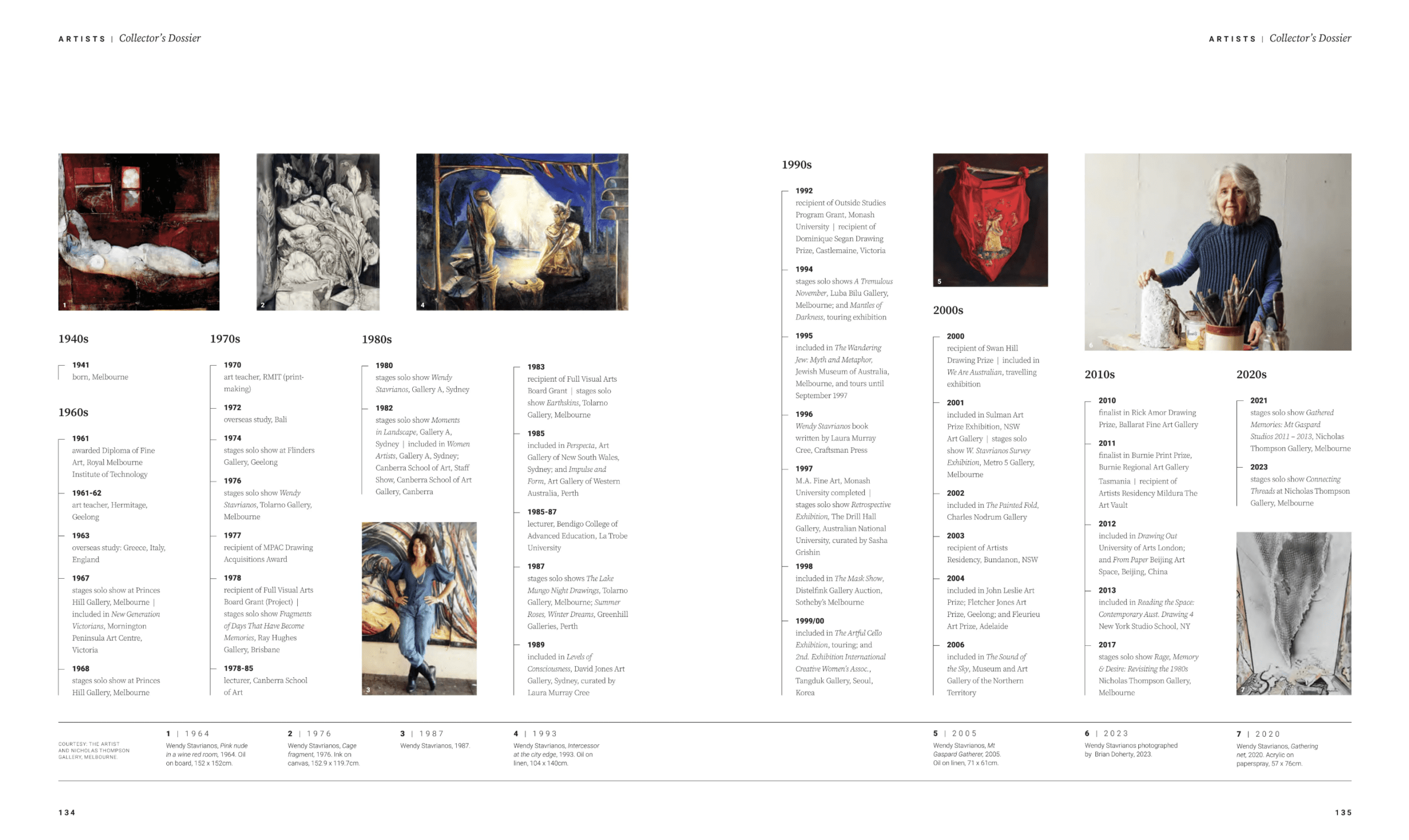

GATHERED MEMORIES - MT GASPARD STUDIOS 2011 - 2013
6 TO 24 APRIL 2021
EXHIBITION PRESS
ARTIST PROFILE MAGAZINE, ISSUE 54 P 114 - 119
Wendy Stavrianos: Paintings from a room
Wendy Stavrianos has a distinctive artistic vision – an artistic personality that is authentic, unique and identifiable from twenty paces and one that is impossible to confuse with the work of any other artist. Her art is deeply autobiographic and consists of symbols and motifs that she has gathered over a lifetime and, with her guidance, it is sometimes possible to decipher the etymology of some of her symbols. However, her art is not illustrative of a personal narrative but alludes to broad, universal themes.
As one of her favourite writers, Jorge Luis Borges, once observed, “A writer – and, I believe, generally all persons – must think that whatever happens to him or her is a resource. All things have been given to us for a purpose, and an artist must feel this more intensely. All that happens to us, including our humiliations, our misfortunes, our embarrassments, all is given to us as raw material, as clay, so that we may shape our art.”[1]

Stavrianos recently observed, “I have now found my own symbols”[2] and these symbols frequently recur in her art in different configurations. She was born in Melbourne in 1941 and spent her childhood years in the 1950s living in the inner Melbourne suburbs where her father worked as a hotel keeper. It was from a window in a hotel room that she, as a child, observed the world, and years later, as an artist, she has returned to the metaphor of a room as a place in which to gather her memories and from which to comment on the world. As Gaston Bachelard famously observed, “the house protects the dreamer, the house allows one to dream in peace.”[3]
A significant painting, City’s Edge, Disjunction, 2016[4] measures slightly under two metres square and, like most of Stavrianos’ work, is executed in acrylic on canvas in a subdued almost monochromatic palette with a high degree of crispness and figurative precision. Although all of the individual elements – the underside of an old metal bridge, traffic signals, suspended nets and fluttering pieces of paper – are all recognisable, meaning remains elusive. This curious composition is pierced with a glimpse of a landscape and a sliding metal surface and despite being painted with a high degree of fidelity and a loving realism they seem curiously incongruent and out of place. The artist explains, “the railway bridge was in front of my room that I could see from my window, when I lived in a hotel in Newmarket as a child … the carriages were full of sheep being transported to the nearby saleyards and I could hear them moaning all night.”[5]
City’s Edge, Disjunction is to some extent a memory painting of lambs being taken to slaughter, as remembered from her room at the Doutta Galla Hotel as a publican’s daughter, but it is also a broader statement about a world that is out of joint – in a state of disjunction – and about crisis and a threatened environment. The wires and the suspended nets may randomly catch floating memories and at the same time, the wires are also things that may string us together. The bolted rusting metal girders of the bridge may evoke permanence but they are also crumbling and the traffic lights may be alluding to the command to stop before the destruction becomes irreversible. Are the floating papers some sort of portent of change that is blowing in the wind and a hint that reality is in a state of change and flux? Stavrianos creates highly immersive paintings, like installations that we are invited to enter and inhabit with our imaginations.
Stavrianos initially trained at the art school at the Royal Melbourne Institute of Technology and then spent many years travelling, especially in Europe and throughout Australia, and decades teaching in Australian art schools. As an artist, she is a superb technician, whose practice extends to sculpture, textiles, graphics as well as painting. In some ways, it is important to appreciate this broader context for her art to understand that the past few decades that she has spent working in her shearing shed studio at Harcourt represents a gathering or the bringing together of decades of experience. In her studio, in front of the large central window is something resembling a shrine, or what the artist calls ‘Gathering matter’ – an assembly of skulls, shells, plants and other miscellaneous objects, or what many artists refer to as ‘source materials’ – gathered over decades of travel. These weathered objects that bear the scars of existing in harsh environments are her touch stone on the many realities that she has brought together in her studio and in her art.
When looking back at a cross-section of her art, including the works Lagoon Fragment, 1976-78, Night Edge, 1986, Room for Borges, 2011/12, Fragments of a Room, 2016, Night Veil, 2018-19 and Archaic Twilight, 2018-19, despite what may appear as a rich diversity, there is also an intrinsic unity. They are all memory works, created spaces that are inhabited by the artist that frequently bring together polarities of being. This is not only the cycle of birth, death and regeneration, but the dualities of light and dark, the spiritual and the physical, the natural environment and the man-built structures, ecstasy and pain and the terrestrial and the celestial. The paintings generally reflect a toughness of their passage through life – the canvas is pinned to the wall or spread on the floor and becomes an arena that preserves the energy of the artist and her performance in the creation of the work. This aspect of expressionist painting is tempered through careful glazing and exactitude in detail in the final execution. Ultimately, each work, is part of a grand self-portrait of the artist.
Borges, evocatively wrote, “A man sets out to draw the world. As the years go by, he peoples a space with images of provinces, kingdoms, mountains, bays, ships, islands, fishes, rooms, instruments, stars, horses, and individuals. A short time before he dies, he discovers that the patient labyrinth of lines traces the lineaments of his own face.”[6] In a certain manner, this is also true of Stavrianos’ art, where despite its rich diversity and fecundity of invention it is essentially a delineation of a very personal quest into being and a plea for survival and preservation. Stravrianos is an artist who adopts an ethical stance in her art with a muffled cry of despair over the carnage that she is witnessing being inflicted on our natural environment. Although expressed from a distinctly feminine perspective, it is all inclusive and universal.
Working in rural central Victoria involves a degree of isolation, but it also enables the artist to adopt a broader perspective than is frequently possible when one is completely submerged within the art scene. Wendy Stavrianos is one of our most neglected and yet most significant senior artists working in Australia today. Although she has held over 50 solo exhibitions and has been represented in scores of Australian and international group shows, she has yet to receive the recognition that her art deserves. As a young art school student she recalls, “people didn’t want my intensity”;[7] perhaps in this changing threatened world we may now need some of her intensity.
Sasha Grishin
[1] Jorge Luis Borges, Twenty-Four Conversations with Borges: Interviews by Roberto Alifano 1981-1983
[2] Wendy Stavrianos, interview with the author, artist’s studio, Harcourt, Victoria, December 18, 2020
[3] Gaston Bachelard, The poetics of space: The classic look at how we experience intimate places, (1958) translated by Maria Jolas, Boston, Beacon Press, 1994, p.6
[4] Wendy Stavrianos, City’s Edge, Disjunction, 2016, acrylic on canvas, 180 x 195cm
[5] Wendy Stavrianos, interview with the author, artist’s studio, Harcourt, Victoria, December 18, 2020
[6] Jorge Luis Borges, The Aleph and Other Stories, (1949), Penguin Classics, 2004
[7] Wendy Stavrianos quoted in Laura Murray Cree, Wendy Stavrianos, Sydney, Craftsman House, 1996, p.6
ARTIST STATEMENT
Auden, the poet said, ‘if you have an unwritten poem inside you and don’t write it, you will cry tears of shame’.
These paintings are my unwritten poem that were stored in the forgotten rooms of the mind, gathering dust.
It is from these childhood rooms, that we make the poem within us.
My journey has been to value the invisible reality, part of the deeper world, the Metaphysical.
The ‘Room’ in my work is read, like a poem is read.
So also is a musical score set in a particular key, as a painting is tonally set in place by an unavoidable subjectivity.
This room of intimacy is a world in itself, a space that can hypnotize us with its memories and with its deeper desires.
We bring to the space of the canvas the micro and the macro view, gathering in what has touched us, beguiled us or sustained our creative life through time.
Wendy Stavrianos, 2011
THROUGH THE WINDOW OF AN INNER ROOM
18 SEPTEMBER TO 13 OCTOBER 2019
EXHIBITION ESSAY
'Wounded beauty' is a term Wendy Stavrianos uses to describe the cycle of birth and death, vibrant growth before eventual withering, and the wilful impact humans bring to their environment and its inevitable consequences. Contained within a bleak view of mankind’s misuse of its most precious resource is a wistful understanding and representation of the vestigial grace that remains, the structure revealed with the bones of nature laid bare by the stripping away of trees, foliage and natural elements revealing the geometric architecture that lies beneath, anchoring the natural world in place and balance.
Working this diminished and scarred landscape, Stavrianos’ attention searches for remnants of the verdant bountiful creation that preceded its denudation, in a process of gathering clues and artefacts that visually comprise the past, and the stoic damaged resilience of the planet and its structures. Portraying a world view of 'last remains', she offers awareness of an unseen environment from the standpoint of the artist, represented by the studio or inner room, with its window providing a portal between one reality and another. Incorporating the concept of architectural Phenomenology as applied by Gaston Bachelard in his book Poetics of Space which links spatiality and lived experience, she sees the room as a space that remembers our presence, and is always carried within us as an emotional and remembered perspective through which we interpret the external domain.
Living under the expansive Australian country sky has bestowed a sense of scale and breadth to Stavrianos’ discourse. Resolving a particular focus from her distinctive surroundings, she refines the greatness of the vista with physical and allusive windows; those of the studio and her mind’s eye, providing an interpretation that converts time worn and altered landscapes to shapes colours and textures. Strikingly described in Archaic Twilight is a large sunset sky mostly obscured by the intrusion of hulking, artificial edifices dominating the scene in a claustrophobic demonstration of man’s industrial footprint. To Stavrianos the forms have a voice of their own and trigger imagination. They summon a realm of deep dark shadows, with a ‘wounded beauty’ set against divine light that shines through the studio window - a light that bleaches all things to silence.
The virtual collecting of small fragments of nature’s remains, and imposing them on the developed world establishes a broad canvas to capture and display long held memories, loss, pain and wonder within the evolving context of civilization’s development. Stavrianos says that she frequently supplements present day observations and gatherings with past recollections of landscapes, relating how she connects these experiences like beads on a string, and ties them together in memory. Eschewing clinical photographic painting, she combines extraordinary, eerie colours and textures drawn from the setting outside her studio in the pursuit of an approach that is entirely psychological and human.
The sometimes ghostly and archaic qualities combine with end of day twilight pinks, deep reds and golden yellows to identify visceral pulsating rhythms that hold gothic undertones, and offer reflection on the propensity for Australian landscapes to be both brutal and magical simultaneously. Stavrianos often employs a triangular shape that secures the image, balancing dominant and delicate strokes to create figurative shell like shapes juxtaposed with fragile spidery lines. Prominent in Sanctuary and Connecting Threads (Beginning) these renderings provide the impression of sails and rigging, suggestive of a forlorn progress now in tatters and disrepair.
Utilising pen to resolve these areas of fine drawing, Stavrianos prefers to draw directly on the cloth for immediacy and employs a staining method of thinly applied acrylic paint which appears more like drawing or mark making. She enjoys letting the image breathe through the layers without varnish so that she can work quickly and with a degree of physicality to produce scenes that will be transformed by light. While Stavrianos continues to admire oil painting, she values the freedom of acrylic to keep the process breathing from the inside to the outside, freely invoked with a dreaming, swaying attitude.
Stavrianos characterises her current work as steeped in forms and symbols rather than purely descriptive, as evident in the recurring circular clock motifs that warn of time running out for our distorted and melting habitat. Other devices submit further evidence of human impact, describing cities, overhead cables and flags as developmental for mankind, and as a vulnerability for nature with their bearing on the environment, and the resultant destruction of habitat. Large nets emanating from the symbolic sail rigging metaphorically enclose what has been drawn in and captured, representing items identified by Stavrianos as sacred and cared for, spiritually and physically. Presenting a view of a dystopian yet somehow redeemable world distilled by the eyes of a skilled and articulate observer, Through the window of an inner room contains a tragic and beautiful narrative on the pursuit of progress and the resilience of this fragile planet.
Caroline Field
1 August 2019
ARTIST STATEMENT
The inner room can be an artist’s studio, for private reverie, or an internal space inhabited when gathering in the threads of what has deeper meaning, and must be given shape and voice.
At my studio window I hang ‘Gathering Matter’, things I have been drawn to over many journeys over Australia. These have become well-loved and observed forms worn, dried out, reduced to an unrecognisable state after years of drought and time. The gatherings reflect back the harsh aspects of the places where they were discovered. They have become ‘their own landscape’. The forms have a voice of their own and trigger the imagination. They create a world of dark deep shadows, with a wounded beauty set against divine light that shines through the studio window, a light that bleaches all things to silence.
Summer’s ferocious rays have reduced all things in its path, golden grasses, white now, like snow, transformed by extreme contrasts, become part of the continuing cycles of life-birth-death and re-birth. As I observe these repeated patterns of ebbs and flows embedded by weather and climate crisis, I see the impacts on all things; the land, the water sources and the creatures that struggle to co-exist with us all.
It seems a new landscape has grown from this reduction, a landscape of ‘last remains’, that was once, and does not exist anymore, what it seems, has been forgotten. From the old growth forests in the early part of the century, only the shards of silver-grey splintered wood remain. The earth has exposed its elemental structures, revealing a sacred geometry.
I am a ‘Gatherer’ here in Central Victoria and a presence that watches all this unfold, observing and remembering from the inner room, and beyond, through ‘Landscapes of Memory’, connecting the threads, like beads on a string strung out across this land.
Wendy Stavrianos, 2019.
Mt Gaspard Studios Central Victoria.
EXHIBITION PRESS
ART: WENDY STAVRIANOS
Lives: Walmer, VIC. Age: 78. Represented by: Nicholas Thompson Gallery, Melbourne; no Sydney gallery.
Her thing.
Expressive, semi-abstract landscapes of the imagination.
Our take.
Wendy Stavrianos’s new works explore that borderline between the studio and the external world, between observation and memory, landscape and invention. It’s been some 30 years since Stavrianos and her artist partner, Craig Gough, moved to a Victorian property at Walmer, between Bendigo and Castlemaine, and the harsh, dry climate has become an integral element in her work.
In her exhibition at Nicholas Thompson Gallery, Through the Window of an Inner Room, Stavrianos uses the shapes of objects and detritus gathered from journeys around Australia as the basis for a meditation on a landscape of “last remains”. Forms drawn directly onto the canvas are filled in with delicate washes of acrylic, creating abstracted vistas with a brooding, apocalyptic aspect.
A painting such as Archaic Twilight depicts a sunset, but a clutter of man-made forms scattered across the canvas suggests that the sun is setting on a world ravaged by climate change. Other pictures such as Sanctuary or Night Veil take us out of the landscape and into the artist’s mind, as she reflects on the gathering darkness she sees from the studio window.
Can I afford it?
The most expensive work in the show is the large painting Connecting Threads (Beginning) (188cm x 263cm, pictured above), at $40,000. This is very reasonable for an artist who held her first solo exhibition in 1967. The lowest price is a mere $450 for each of six small works on paper called Study (9.5cm x 14cm). As the title suggests, these small pictures are studies for the larger canvases. Neither the artist nor her gallery is certain about her record price, but there has been a number of sales in excess of $50,000. The current show is the most substantial group of new works Stavrianos has shown in years.
Where can I have a squiz?
Nicholas Thompson Gallery, 155 Langridge Street, Collingwood, until October 13
John McDonald 'Sydney Morning Herald' Saturday 20 September
OPENING SPEECH
'I must confess that my primary research areas to date have been performance art and photography and, much of what I’ve written, when I’ve written about painting, has been inflected with my study of performance and photography. However, I’ve been immersed in a big study of contemporary Australian women artists over the last few years and it is here that I first encountered Wendy’s work in detail.
Wendy Stavrianos’ career demonstrates the ways in which an artist emerges and evolves, it clearly shows how experimentation drives studio practice and the ways in which issues dear to the heart of the artist are consistently explored.
When I was doing research for my new book, I was looking for key paintings, often early-ish in the artist’s career, as a way to bring to the reader the pioneering works of women artists. When I looked at Wendy’s work, it was Mungo Lovers (Rape of the land), 1986-87, that bounced off the page. It is a profound work, a diptych, monumental in scale, and resonating with emotion and symbolism. Mungo Lovers was an operatic performance of love, death, nature, and it remains an ecological painting of great force. I’m sure many of you had the opportunity to see the whole suite of Mungo paintings here at Nicholas Thompson Gallery in 2017 so they are relatively fresh in your mind (and on the gallery website if you missed it).


Wendy Stavrianos 'Mungo Lovers (The Rape of the Land)' 1986-87 Oil on canvas, bone 167 x 426 cm
I wanted to mention this work because it is representative of the triumph of Stavrianos’ painting, sculpture and textile-painting installations in art history. In the history of Western painting, it wasn’t that long ago, less than 100 years, that only male artists did big history paintings and of course they did not provide a female voice. Wendy Stavrianos is pioneering in this regard as she brings the female experience to bare on art and its history. Time and again throughout her career the female form recurs in nature as sexual being. In some of her early works such as Celebration of Woman (1977-78) and the Night series of the mid-1980s the sexualised female body becomes iconic in the landscape. Stavrianos’ body of work since the 1970s is arguably one of the most compelling in terms of its exploration of the natural role of the female body and it has, as Laura Murray Cree acknowledges in her monograph on the artist, been largely unacknowledged. I think this is probably because the artist’s exploration is so passionate and deeply philosophical and spiritual: it looks at mythology, the psyche and its archetypes, literature and religion. It is not a quick, easy, political statement about women or sexism that has come to flood the feminist art agenda. In many ways, it is a timeless art that resists stereotypes and convention, but it is nevertheless a very radical intervention that monumentalises the core principles of the feminine, something that feminism has been divided about since suffrage.
The melding of the female body and nature that Stavrianos uses to anthropomorphise her works allows her to present the ecological in personal and archetypal ways. But the works are also deep in their exploration of psyche and self, the dark side of the unconscious, the fragmentation of the dream state in scenes of horror, complicity and carnage. Critics have compared her work to Goya, among others.
The works on the walls today still focus on the landscape and underscore an ecological scene but here the artist is calmer, the voice softer, as she looks towards and through the window of an interior room (the studio and her own internal imagination). In the studio window she hangs ‘gathering matter’ that she has collected from the landscape, gatherings that make their own landscape but become other landscapes as the light shines through them at different times and seasons. She says that the “forms have a voice of their own and trigger the imagination. They create a world of dark deep shadows, with a wounded beauty set against divine light . . . a light that bleaches all things to silence”.
My fascination with the ontology of photography brings me to see these works in terms of the camera and the glass window as a kind of film where the images are transient and illusive. The ontology of photography is apparent as the painter uses the glass to capture something that has been there, just there, just now. A bit like the self that is described by that famous French psychoanalyst Jacques Lacan when he says so poetically that it is: “there where it was just now, there where it was for a while: between an extension that is still glowing and a birth that is retarded, ‘I’ can come into being and disappear from what I say”. [Ecrits: 300]
Wendy Stavrianos’ window is the window ‘of an interior room’, and, given the artists love of symbolism and metaphor, one can hardly ignore what this might mean. She could have simply said ‘through the window’ and left it there, perhaps referring to painting as a window onto the world. But the ‘interior room’ is much more poetic and associated with the psyche. Whiteness, that the artist has said she associates with death, washes through the canvases, and circular shapes - interpreted as a clock punctuating the works - point to time passing. Sails drift across the canvasses and industrial motifs recur. The window’s transparent materiality provides a shifting palimpsest that allows multiple mappings to come and go as the artist sings silent, visual songs, depicting the unbecoming of the earth and the devastation wrought by human-inspired progress that scars the land. But there’s also a hopefulness here as the artist refers to a sacred geometry which is exposed in elemental structures. A wounded beauty amidst divine light. Suggesting perhaps that humankind and civilization itself may be erased through its own progress, but the earth, albeit wounded, will live to recreate itself in another form. There’s a kind of cosmology resonating somewhere here, peeking through the window floating in the light.
It seems to me that Wendy Stavrianos is a great artist and she gives to us a sophisticated and heart felt engagement with the human, on this planet, at this time, with all of our troubles, our pains, our joy. It is a great honour to be asked to say some words about her work. Thank you for listening.'
Professor Anne Marsh, Saturday 21 September 2019
EXHIBITION WORKS
EXHIBITION INSTALLATION
RAGE, MEMORY AND DESIRE: REVISITING THE 1980s
16 SEPTEMBER TO 8 OCTOBER 2017
EXHIBITION PRESS
"Nicholas Thompson presents an exhibition that marks the fiftieth anniversary of Wendy Stavrianos' first solo exhibition in 1967. To mark this significant point in Stavrianos’ career, the exhibition ‘Rage, Memory & Desire: Revisiting the 1980s’ looks to a powerful and potent period... Loaded with narrative from Australia and Europe, the visually intense paintings need to be experienced in person in order to be immersed in Stavrianos’ poetic abstraction....'
extract from Lucy Stranger's preview for 'Artist Profile'
Link to full article here
ARTIST STATEMENT
The 1980’s was for me an incredibly creative time, although a period of great upheaval. There was an outpouring of work between 1980 and 1990 that expressed authentic emotions, not of the fake kind. These were so overpowering at times that they seemed to break through a wall inside me, shattering all the past conditioning that had been built up since childhood. It was as if I had come to a crossroad, where life and art merged and could not be separated. I felt then, that my passion had at last found its form.”
GALLERY STATEMENT
When Wendy Stavrianos and I discussed staging a survey exhibition, we agreed that we should revisit and acknowledge the powerful, uncompromising and potent work in her archive. Rather than a broad career overview, Wendy preferred from the outset to focus on one particularly charged period - the mid to late 1980s. This concentration in chronology adds to the intensity of the works, when experienced as a group their impact is undeniable.
Wendy Stavrianos occupies a unique position in contemporary Australian art. Her work demonstrates expressionism in its purest form, where emotion and technique, poetics and pragmatics are inextricably entwined. Her images simultaneously engage with the external landscape of the tangible and the interior landscape of the self. Stavrianos’ practice over the last fifty years has spanned painting, sculpture, construction, installation, drawing and printmaking. Her work is informed by rich life experience. She has lived, worked, taught and exhibited in Melbourne, Sydney, Darwin, Canberra as well as internationally. Stavrianos settled outside Castlemaine in the 1980s, where she continues to work, exhibiting throughout Australia.
I am delighted to present this survey exhibition of Wendy Stavrianos at Nicholas Thompson Gallery, in the milestone year of the fiftieth anniversary of the artist’s first solo exhibition in 1967.
Nicholas Thompson 2017
CATALOGUE ESSAY 'WHO'S AFRAID OF WENDY STAVRIANOS?' LAURA MURRAY CREE
The Sick Rose
O Rose thou art sick.
The invisible worm
That flies in the night
In the howling storm
Has found out thy bed
Of crimson joy
And his dark secret love
Does thy life destroy.
William Blake
The fire that consumed the body of an Aboriginal woman after her death at Lake Mungo more than 40,000 years ago is palpable in a small selection of paintings and drawings by Wendy Stavrianos titled Rage, Memory and Desire. Revisiting the 80s, exhibited at Nicholas Thompson Gallery in Spring 2017.
The works draw on landscape imagery from sites that gathered significance for Stavrianos during a decade when she experienced periods of intense personal transformation. Among them are the fossilised dunes of the dry Willandra Lakes in Mungo National Park, where the remains of ‘Mungo Woman’ were discovered; the wet black rocks of coastal Tanja in New South Wales; and the old rose garden at the artist’s rural property in Victoria, where she relocated from Canberra in the mid 1980s. In the previous decade, she had also experienced the accelerated cycles of nature in Darwin’s tropical climate, and the pollution of land and waterways as a result of uranium mining at Rum Jungle in the Northern Territory.
Equally important to the development of her art was exposure to masterworks during European travels. In the works on exhibition, Uccello’s Rout of San Romano, c.1438–40 at London’s National Gallery and Matthias Grünewald’s Isenheim Altarpiece, 1512–16 are of particular importance, along with Jungian psychology and the feminist project of academic Camille Paglia to unite the Apollonian male principle of the sky gods and the Chthonian body of mother earth.
The bound, masked, human form seen in the drawing Unearthed (The Struggle), 1988, had its first incarnation as part of an installation by Stavrianos for ‘Australian Perspecta 1985’, held at the Art Gallery of New South Wales.[i] Titled Trinity, 1984–85, the work comprised a mummified sculptural form lying on an alchemical bed fringed with triangular fragments of waxed and painted cloth. The bed was connected by loose chords to a painting depicting the reanimation of the chrysalis-form within an ancestral womb softened by pink and blue light.
The Mungo Woman drawings, taken from the artist’s 1985 Night Series, were created at Tanja a week after her first visit to Lake Mungo. They express the vulnerable beauty of the creature birthed in the metaphysical space of the Trinity painting, while also recalling Botticelli’s mythic Venus-figure emerging from the sea on a shell.
The Rose and Thorn canvases from 1987 represent the betrayal of innocence. In these works, partially hidden female forms are found in archetypal shelters under night skies or plunging beneath torrents of cascading blooms and treacherous severed stems. The diagonal force of these extraordinary paintings owes much to the bold composition and dynamic arrangement of staves, spears and mounts in The Rout of San Romano. But where Uccello creates emotional distance by eliminating the bloody aspects of war and pairing linear perspective and foreshortening with the stylised forms and decorative qualities of medieval painting, Stavrianos accentuates emotional extremes with lashings of luscious colour as roses of exceptional beauty are pinioned or scarred by spikes and thorns.
Mungo Lovers (Rape of the Earth) from 1986–87, a pivotal work within this exhibition, is operatic in scale and composition of the landscape across two horizontal panels; in the repetition of layered, sweeping, diagonal forms; in the resplendent, glowing colours that unite figures and landscape; and in the morphing of staves and spears into a rich, heavily veiled canopy for the lovers, where imminent penetration has become a literal pointing of the bone.
Stavrianos had in mind Grünewald’s magisterial altarpiece depicting Christ’s Crucifixion, Resurrection and Ascension when she created Mungo Lovers (Rape of the Earth). Both are highly ambitious undertakings, raising eternal questions about Nature, Truth and Love. Both, in their different ways, can be read in spiritual terms as Alpha and Omega, Beginning and End. For contemporary viewers, Stavrianos paints a brutally honest picture of humankind in relationship with each other and with the earth, that is as relevant today as it was in the 1980s – and perhaps 2000, or even 40,000 years ago.
Laura Murray Cree
10 June 2017
[i] Trinity isn’t shown in the AGNSW online archive of works from ‘Perspecta 1985’; it is, however, reproduced in the catalogue with an essay by Peter Haynes.
EXHIBITION WORKS
EXHIBITION INSTALLATION
NEWS
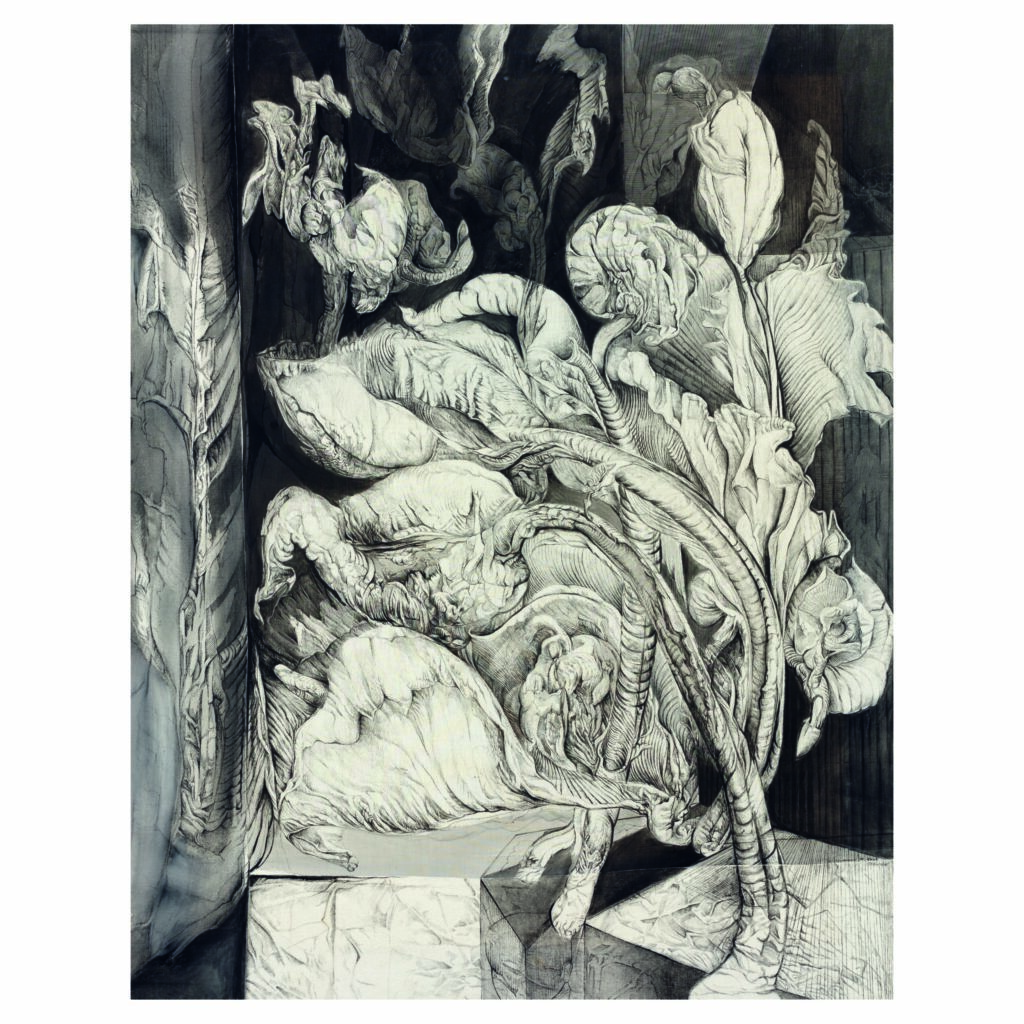
WENDY STAVRIANOS IN ‘SIGNIFICANT OTHERS’ AT ART GALLERY OF BALLARAT
Wendy Stavrianos ‘Cage Fragment’ 1976 is currently exhibited at the Art Gallery of Ballarat in the exhibition ‘Significant Others’ until 11 February 2024 The exhibition celebrates connections between artists and their works in the Gallery’s outstanding Collection, exploring a range of different relationships between pairs of artists – as partners, family members, teachers, mentors or…

WENDY STAVRIANOS COLLECTOR’S DOSSIER BY ANNE MARSH IN ‘ART COLLECTOR’ ISSUE 106
Wendy Stavrianos campaigns for the soul of the earth and our embodied connection to it; exploring a psychological connection between nature, body and mind has sometimes been political, but mostly philosophical. When I emailed Wendy about this article asking for explanations from her that would assist an understanding of her practice over several decades, she…

WENDY STAVRIANOS ‘CONNECTING THREADS’ EXHIBITED IN QUEENSLAND ART GALLERY | GALLERY OF MODERN ART’S AUSTRALIAN ART COLLECTION
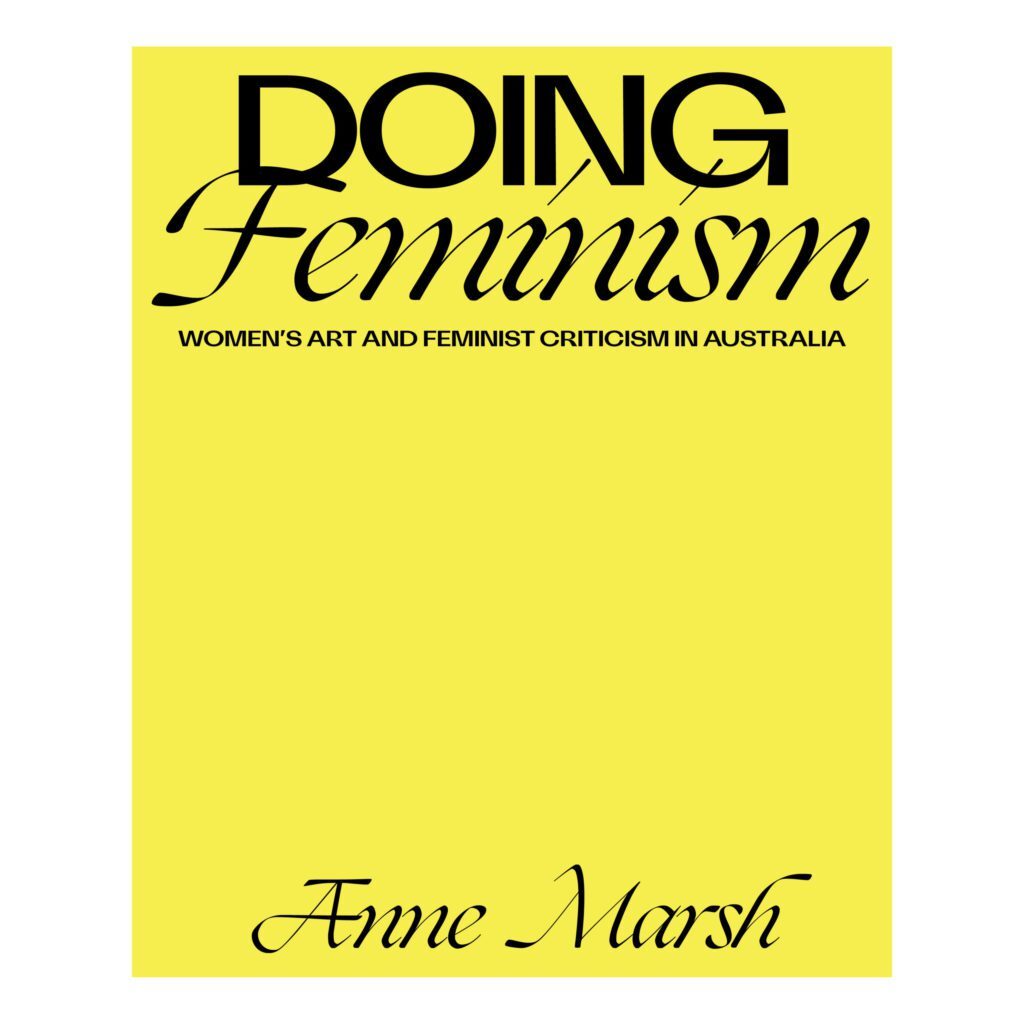
SUZANNE ARCHER, SU BAKER & WENDY STAVRIANOS INCLUDED IN ANNE MARSH ‘DOING FEMINISM: WOMEN’S ART & FEMINIST CRITICISM IN AUSTRALIA’ PUBLISHED BY THE MIEGUNYAH PRESS
“A bold and strikingly illustrated record of women’s art and feminism in Australia, ‘Doing Feminism’ represents over 220 artists and groups with 370 colour illustrations punctuated by extracts from artists’ statements, curatorial writing and critique. Tracking networks of art practice, exhibitions, protest and critical thought over several generations, Marsh demonstrates the innovation and power of…

WENDY STAVRIANOS FEATURE BY SASHA GRISHIN IN ISSUE 54 OF ‘ARTIST PROFILE’
Wendy Stavrianos: Paintings from a room Wendy Stavrianos has a distinctive artistic vision – an artistic personality that is authentic, unique and identifiable from twenty paces and one that is impossible to confuse with the work of any other artist. Her art is deeply autobiographic and consists of symbols and motifs that she has gathered…

WENDY STAVRIANOS FEATURED ON ART GUIDE AUSTRALIA’S ‘THE LONG RUN’ PODCAST
The Long Run #2: Wendy Stavrianos on landscape, nature and gender barriers PODCAST Tiarney Miekus, 4 September 2020 What does it mean to create and innovate over six decades? Art Guide Australia’s newest podcast series The Long Run considers this question with three artists who have had careers spanning sixty years, each reflecting on their…


